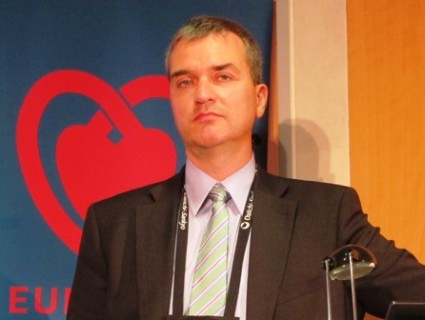User login
MUNICH – One-year results of the ACCESS-EUROPE study confirm the safety and benefits of percutaneous mitral valve repair with the MitraClip in high-risk patients with heart failure, although patient selection remains a critical issue going forward.
The severity of mitral regurgitation was improved to a meaningful extent in about 80% of patients, and was accompanied by significant improvements at 1 year in New York Heart Association (NYHA) functional class, quality of life, and 6-minute walk test distance in about 70%.
"The MitraClip therapy therefore provides a treatment option for a patient population with an important unmet clinical need," Dr. Wolfgang Schillinger said at the annual congress of the European Society of Cardiology.
The MitraClip device has been approved in Europe since 2008 and implanted in more than 6,000 patients worldwide, but is not commercially available in the United States.
Dr. Schillinger pointed out that the results provide a "picture of the real-world treatment in Europe," and are consistent with those from clinical trials, even though ACCESS-EU patients were older and sicker than those in the pivotal, randomized EVEREST II trial.
The 567 patients enrolled in the ACCESS-EU registry were described as having abundant comorbidities, including coronary artery disease in 63% and moderate to severe renal failure in 42%, and severe symptoms of end-stage heart failure, with 85% in NYHA functional class III or IV. The average logistic EuroSCORE was 23, 77% presented with functional mitral regurgitation (MR), and 98% had MR grade 3+ or higher. Their mean age was 74 years.
In contrast, the average age was 67 years in the phase II EVEREST II study, where 73% of the device patients had degenerative MR. Less than half (47%) had coronary artery disease, and only 3% had moderate/severe renal failure.
Study discussant Dr. Simon Ray, with the Manchester (U.K.) Academic Health Science Centre, said ACCESS-EU confirms data from smaller registries and that the majority of MitraClip procedures are now performed in comorbid, sick patients with functional MR, and not in the patients included in EVEREST II.
"So clinical practice has evolved beyond the envelope provided by the evidenced-based, single randomized controlled trial in this field," he said.
The 2012 European Society of Cardiology (ESC) Heart Failure Guidelines state that in patients with an indication for valve repair, but judged inoperable or at unacceptably high surgical risk, percutaneous edge-to-edge repair "may be considered" in order to improve symptoms.
The key going forward is to make sure patients undergoing this procedure genuinely have severe MR, that the assessment of operative risk reflects that of surgeons involved in the decision-making, and that the procedure is only done to improve symptoms, Dr. Ray said.
"There is no evidence that percutaneous edge-to-edge repair improves survival in this patient group," he said.
The decision to choose the less invasive catheter-based therapy over surgery was left up to the 14 ACCESS-EU registry sites.
The MitraClip device was successfully implanted in 99.6% of patients, an improvement over the 86% procedural rate during early experience with the implant in EVEREST II (N. Engl. J. Med. 2011;364:1395-406).
Mortality was low at 3.4% at 30 days, "which is a very good result in view of the comorbidities and the increased risk of the procedures," said Dr. Schillinger, with the University Medical Center Göttingen, Germany.
The most frequently reported safety events were moderate to severe renal failure in 4.8% of patients and bleeding complications in 4%, and the event rates remained low even in higher-risk patients with a EuroSCORE above 20.
At 1 year, 82% of patients were free from death, 79% had MR grade 2 or lower, and 72% were NYHA class I or II.
Significant gains were also made in quality of life scores, averaging 13.5 points from baseline on the Minnesota Living with Heart Failure Questionnaire (from 41.6 to 28.1), and averaging 59.5 m (from 275 to 334 m) in the 6-minute walk test, he said.
"What this registry does, and it is very important, is to raise perhaps more questions than it provides answers, and a number of these are around patient selection," Dr. Ray said.
What’s known from the current registry and others is that 25%-35% of patients will derive little or no symptomatic benefit from percutaneous repair. What’s not clear is whether this is due to incorrect or insufficiently sophisticated assessment of valve anatomy or overestimation of the severity of the MR because quantitative techniques have not generally been used in the registries, he said. It’s also possible that patients are being included with such severe degrees of left ventricular dysfunction that they are unlikely to benefit.
"We also need to have an eye on what constitutes success, because a technically successful procedure leading to a reduction in mitral valve regurgitation in these patients is coincidental, if they do not also have some symptomatic and functional benefit," he added.
Finally, Dr. Ray called for a pragmatic randomized trial, driven by a heart team, comparing optimized medical therapy with the addition of cardiac resynchronization therapy, where indicated, against that treatment plus the MitraClip device.
The phase III COAPT (Clinical Outcomes Assessment of the MitraClip Percutaneous Therapy for High Surgical Risk Patients) trial in moderate to severe or severe functional MR patients is not yet recruiting, but will compare the MitraClip device with patients managed nonsurgically based on standard hospital practice. REALISM (Real World Expanded Multicenter Study of the MitraClip System), the phase III follow-up to EVEREST II, continues to enroll patients in the United States and Canada, with a final completion date of December 2016.
Dr. Schillinger reported receiving consulting fees/honoraria from study sponsor Abbott Vascular, as well as Abiomed, AstraZeneca, Edwards Lifesciences, Servier, and St. Jude Medical. Dr. Ray reported no relevant conflicts of interest.
The 2012 European Society of Cardiology (ESC) Heart Failure Guidelines,
MUNICH – One-year results of the ACCESS-EUROPE study confirm the safety and benefits of percutaneous mitral valve repair with the MitraClip in high-risk patients with heart failure, although patient selection remains a critical issue going forward.
The severity of mitral regurgitation was improved to a meaningful extent in about 80% of patients, and was accompanied by significant improvements at 1 year in New York Heart Association (NYHA) functional class, quality of life, and 6-minute walk test distance in about 70%.
"The MitraClip therapy therefore provides a treatment option for a patient population with an important unmet clinical need," Dr. Wolfgang Schillinger said at the annual congress of the European Society of Cardiology.
The MitraClip device has been approved in Europe since 2008 and implanted in more than 6,000 patients worldwide, but is not commercially available in the United States.
Dr. Schillinger pointed out that the results provide a "picture of the real-world treatment in Europe," and are consistent with those from clinical trials, even though ACCESS-EU patients were older and sicker than those in the pivotal, randomized EVEREST II trial.
The 567 patients enrolled in the ACCESS-EU registry were described as having abundant comorbidities, including coronary artery disease in 63% and moderate to severe renal failure in 42%, and severe symptoms of end-stage heart failure, with 85% in NYHA functional class III or IV. The average logistic EuroSCORE was 23, 77% presented with functional mitral regurgitation (MR), and 98% had MR grade 3+ or higher. Their mean age was 74 years.
In contrast, the average age was 67 years in the phase II EVEREST II study, where 73% of the device patients had degenerative MR. Less than half (47%) had coronary artery disease, and only 3% had moderate/severe renal failure.
Study discussant Dr. Simon Ray, with the Manchester (U.K.) Academic Health Science Centre, said ACCESS-EU confirms data from smaller registries and that the majority of MitraClip procedures are now performed in comorbid, sick patients with functional MR, and not in the patients included in EVEREST II.
"So clinical practice has evolved beyond the envelope provided by the evidenced-based, single randomized controlled trial in this field," he said.
The 2012 European Society of Cardiology (ESC) Heart Failure Guidelines state that in patients with an indication for valve repair, but judged inoperable or at unacceptably high surgical risk, percutaneous edge-to-edge repair "may be considered" in order to improve symptoms.
The key going forward is to make sure patients undergoing this procedure genuinely have severe MR, that the assessment of operative risk reflects that of surgeons involved in the decision-making, and that the procedure is only done to improve symptoms, Dr. Ray said.
"There is no evidence that percutaneous edge-to-edge repair improves survival in this patient group," he said.
The decision to choose the less invasive catheter-based therapy over surgery was left up to the 14 ACCESS-EU registry sites.
The MitraClip device was successfully implanted in 99.6% of patients, an improvement over the 86% procedural rate during early experience with the implant in EVEREST II (N. Engl. J. Med. 2011;364:1395-406).
Mortality was low at 3.4% at 30 days, "which is a very good result in view of the comorbidities and the increased risk of the procedures," said Dr. Schillinger, with the University Medical Center Göttingen, Germany.
The most frequently reported safety events were moderate to severe renal failure in 4.8% of patients and bleeding complications in 4%, and the event rates remained low even in higher-risk patients with a EuroSCORE above 20.
At 1 year, 82% of patients were free from death, 79% had MR grade 2 or lower, and 72% were NYHA class I or II.
Significant gains were also made in quality of life scores, averaging 13.5 points from baseline on the Minnesota Living with Heart Failure Questionnaire (from 41.6 to 28.1), and averaging 59.5 m (from 275 to 334 m) in the 6-minute walk test, he said.
"What this registry does, and it is very important, is to raise perhaps more questions than it provides answers, and a number of these are around patient selection," Dr. Ray said.
What’s known from the current registry and others is that 25%-35% of patients will derive little or no symptomatic benefit from percutaneous repair. What’s not clear is whether this is due to incorrect or insufficiently sophisticated assessment of valve anatomy or overestimation of the severity of the MR because quantitative techniques have not generally been used in the registries, he said. It’s also possible that patients are being included with such severe degrees of left ventricular dysfunction that they are unlikely to benefit.
"We also need to have an eye on what constitutes success, because a technically successful procedure leading to a reduction in mitral valve regurgitation in these patients is coincidental, if they do not also have some symptomatic and functional benefit," he added.
Finally, Dr. Ray called for a pragmatic randomized trial, driven by a heart team, comparing optimized medical therapy with the addition of cardiac resynchronization therapy, where indicated, against that treatment plus the MitraClip device.
The phase III COAPT (Clinical Outcomes Assessment of the MitraClip Percutaneous Therapy for High Surgical Risk Patients) trial in moderate to severe or severe functional MR patients is not yet recruiting, but will compare the MitraClip device with patients managed nonsurgically based on standard hospital practice. REALISM (Real World Expanded Multicenter Study of the MitraClip System), the phase III follow-up to EVEREST II, continues to enroll patients in the United States and Canada, with a final completion date of December 2016.
Dr. Schillinger reported receiving consulting fees/honoraria from study sponsor Abbott Vascular, as well as Abiomed, AstraZeneca, Edwards Lifesciences, Servier, and St. Jude Medical. Dr. Ray reported no relevant conflicts of interest.
MUNICH – One-year results of the ACCESS-EUROPE study confirm the safety and benefits of percutaneous mitral valve repair with the MitraClip in high-risk patients with heart failure, although patient selection remains a critical issue going forward.
The severity of mitral regurgitation was improved to a meaningful extent in about 80% of patients, and was accompanied by significant improvements at 1 year in New York Heart Association (NYHA) functional class, quality of life, and 6-minute walk test distance in about 70%.
"The MitraClip therapy therefore provides a treatment option for a patient population with an important unmet clinical need," Dr. Wolfgang Schillinger said at the annual congress of the European Society of Cardiology.
The MitraClip device has been approved in Europe since 2008 and implanted in more than 6,000 patients worldwide, but is not commercially available in the United States.
Dr. Schillinger pointed out that the results provide a "picture of the real-world treatment in Europe," and are consistent with those from clinical trials, even though ACCESS-EU patients were older and sicker than those in the pivotal, randomized EVEREST II trial.
The 567 patients enrolled in the ACCESS-EU registry were described as having abundant comorbidities, including coronary artery disease in 63% and moderate to severe renal failure in 42%, and severe symptoms of end-stage heart failure, with 85% in NYHA functional class III or IV. The average logistic EuroSCORE was 23, 77% presented with functional mitral regurgitation (MR), and 98% had MR grade 3+ or higher. Their mean age was 74 years.
In contrast, the average age was 67 years in the phase II EVEREST II study, where 73% of the device patients had degenerative MR. Less than half (47%) had coronary artery disease, and only 3% had moderate/severe renal failure.
Study discussant Dr. Simon Ray, with the Manchester (U.K.) Academic Health Science Centre, said ACCESS-EU confirms data from smaller registries and that the majority of MitraClip procedures are now performed in comorbid, sick patients with functional MR, and not in the patients included in EVEREST II.
"So clinical practice has evolved beyond the envelope provided by the evidenced-based, single randomized controlled trial in this field," he said.
The 2012 European Society of Cardiology (ESC) Heart Failure Guidelines state that in patients with an indication for valve repair, but judged inoperable or at unacceptably high surgical risk, percutaneous edge-to-edge repair "may be considered" in order to improve symptoms.
The key going forward is to make sure patients undergoing this procedure genuinely have severe MR, that the assessment of operative risk reflects that of surgeons involved in the decision-making, and that the procedure is only done to improve symptoms, Dr. Ray said.
"There is no evidence that percutaneous edge-to-edge repair improves survival in this patient group," he said.
The decision to choose the less invasive catheter-based therapy over surgery was left up to the 14 ACCESS-EU registry sites.
The MitraClip device was successfully implanted in 99.6% of patients, an improvement over the 86% procedural rate during early experience with the implant in EVEREST II (N. Engl. J. Med. 2011;364:1395-406).
Mortality was low at 3.4% at 30 days, "which is a very good result in view of the comorbidities and the increased risk of the procedures," said Dr. Schillinger, with the University Medical Center Göttingen, Germany.
The most frequently reported safety events were moderate to severe renal failure in 4.8% of patients and bleeding complications in 4%, and the event rates remained low even in higher-risk patients with a EuroSCORE above 20.
At 1 year, 82% of patients were free from death, 79% had MR grade 2 or lower, and 72% were NYHA class I or II.
Significant gains were also made in quality of life scores, averaging 13.5 points from baseline on the Minnesota Living with Heart Failure Questionnaire (from 41.6 to 28.1), and averaging 59.5 m (from 275 to 334 m) in the 6-minute walk test, he said.
"What this registry does, and it is very important, is to raise perhaps more questions than it provides answers, and a number of these are around patient selection," Dr. Ray said.
What’s known from the current registry and others is that 25%-35% of patients will derive little or no symptomatic benefit from percutaneous repair. What’s not clear is whether this is due to incorrect or insufficiently sophisticated assessment of valve anatomy or overestimation of the severity of the MR because quantitative techniques have not generally been used in the registries, he said. It’s also possible that patients are being included with such severe degrees of left ventricular dysfunction that they are unlikely to benefit.
"We also need to have an eye on what constitutes success, because a technically successful procedure leading to a reduction in mitral valve regurgitation in these patients is coincidental, if they do not also have some symptomatic and functional benefit," he added.
Finally, Dr. Ray called for a pragmatic randomized trial, driven by a heart team, comparing optimized medical therapy with the addition of cardiac resynchronization therapy, where indicated, against that treatment plus the MitraClip device.
The phase III COAPT (Clinical Outcomes Assessment of the MitraClip Percutaneous Therapy for High Surgical Risk Patients) trial in moderate to severe or severe functional MR patients is not yet recruiting, but will compare the MitraClip device with patients managed nonsurgically based on standard hospital practice. REALISM (Real World Expanded Multicenter Study of the MitraClip System), the phase III follow-up to EVEREST II, continues to enroll patients in the United States and Canada, with a final completion date of December 2016.
Dr. Schillinger reported receiving consulting fees/honoraria from study sponsor Abbott Vascular, as well as Abiomed, AstraZeneca, Edwards Lifesciences, Servier, and St. Jude Medical. Dr. Ray reported no relevant conflicts of interest.
The 2012 European Society of Cardiology (ESC) Heart Failure Guidelines,
The 2012 European Society of Cardiology (ESC) Heart Failure Guidelines,
AT THE ANNUAL CONGRESS OF THE EUROPEAN SOCIETY OF CARDIOLOGY
Major Finding: At 1 year, 82% of patients were alive, 79% had mitral regurgitation grade 2 or lower, and 72% were NYHA class I or II.
Data Source: This was a multicenter, prospective, observational study of 567 heart failure patients with severe mitral valve regurgitation.
Disclosures: Dr. Schillinger reported receiving consulting fees/honoraria from study sponsor Abbott Vascular, as well as Abiomed, AstraZeneca, Edwards Lifesciences, Servier, and St. Jude Medical. Dr. Ray reported no relevant conflicts of interest.


